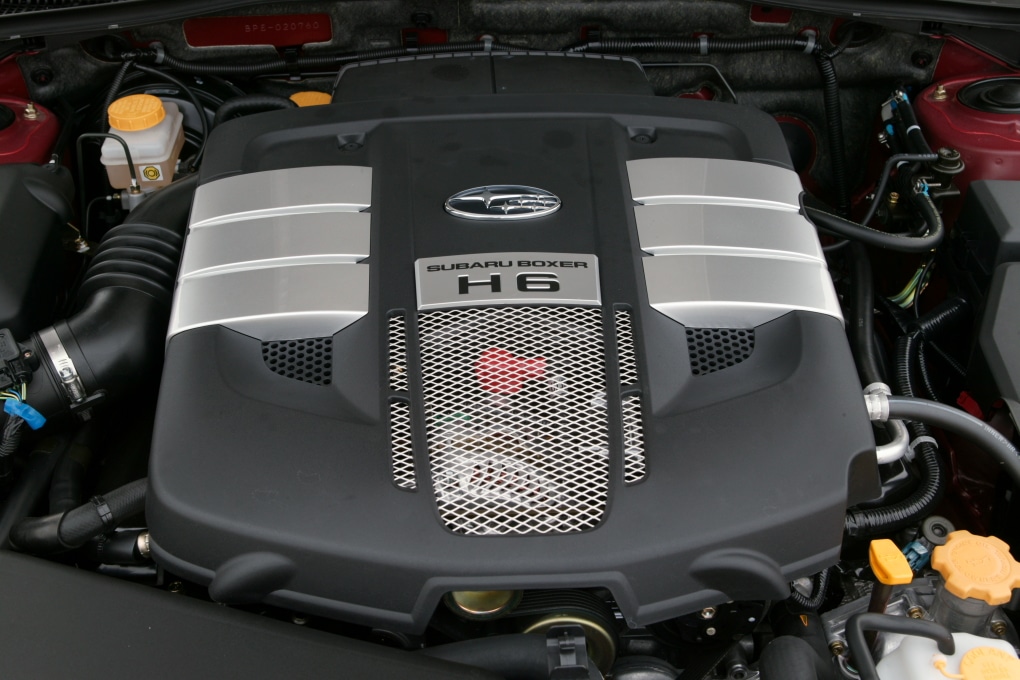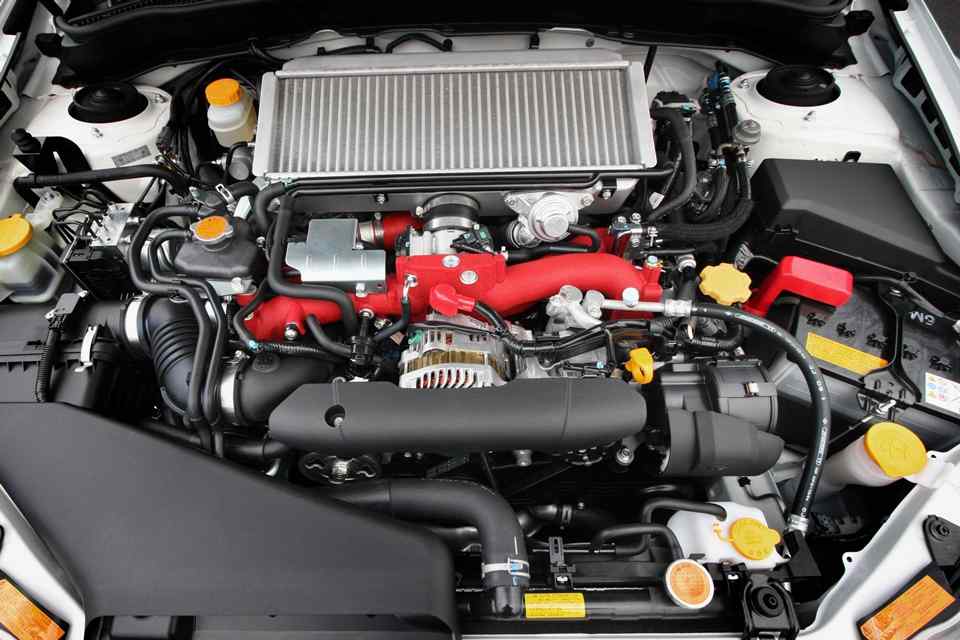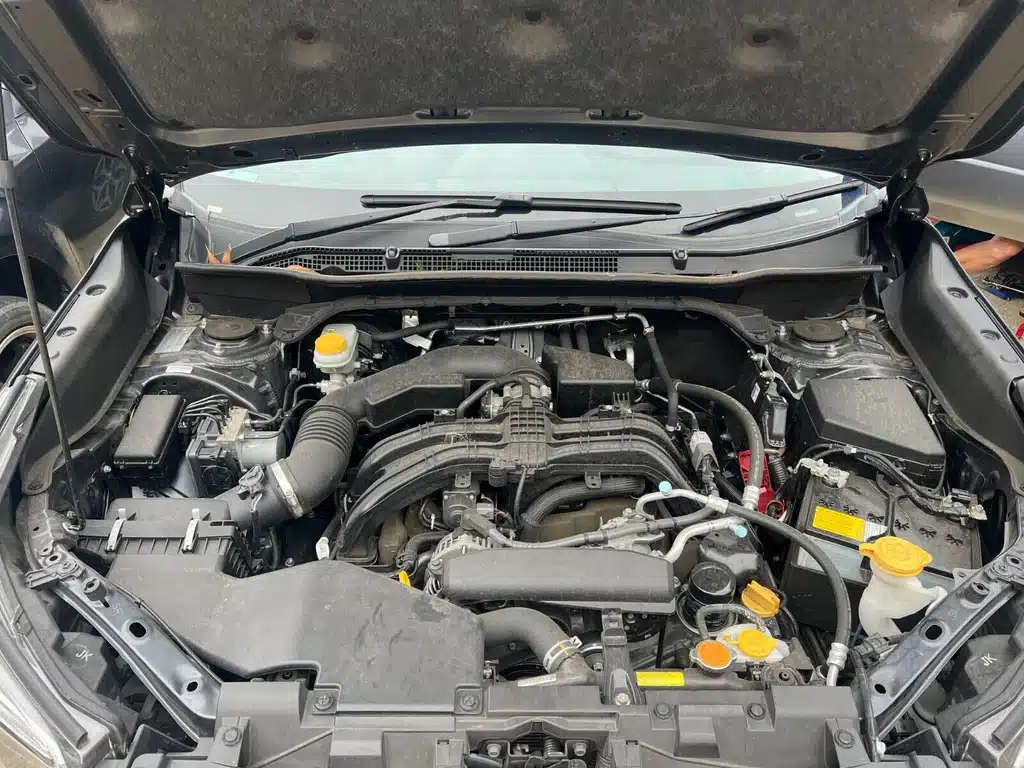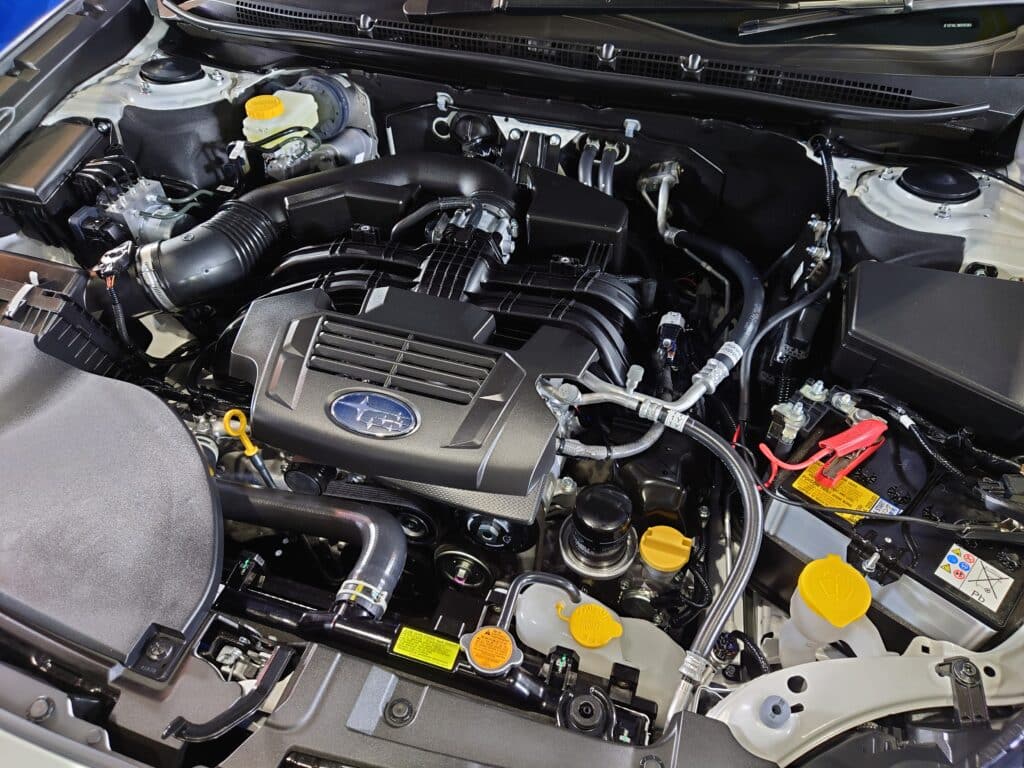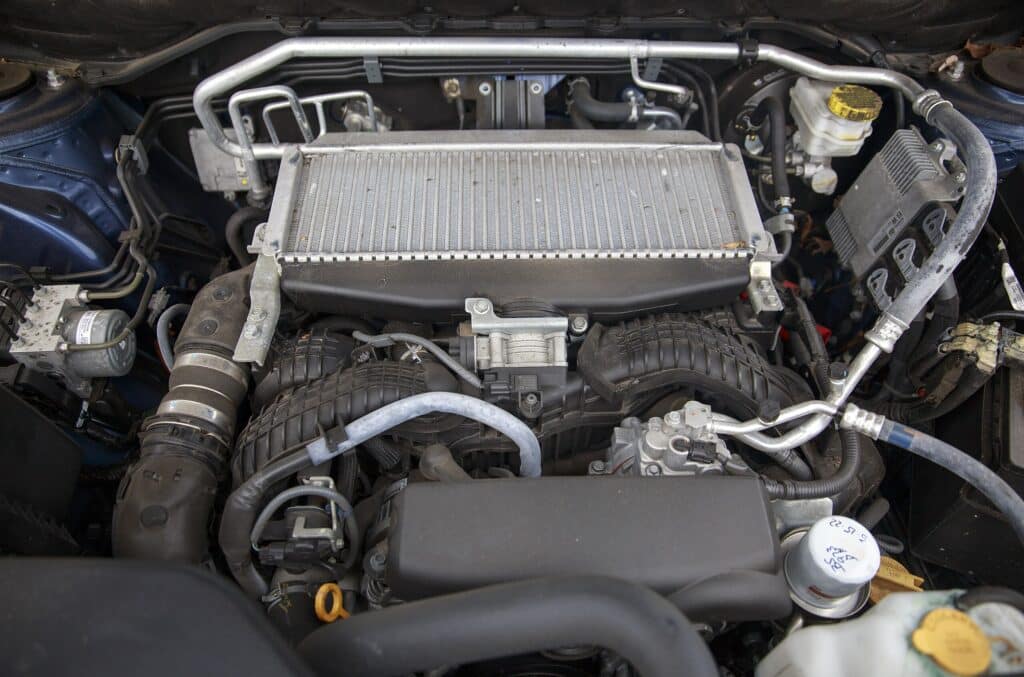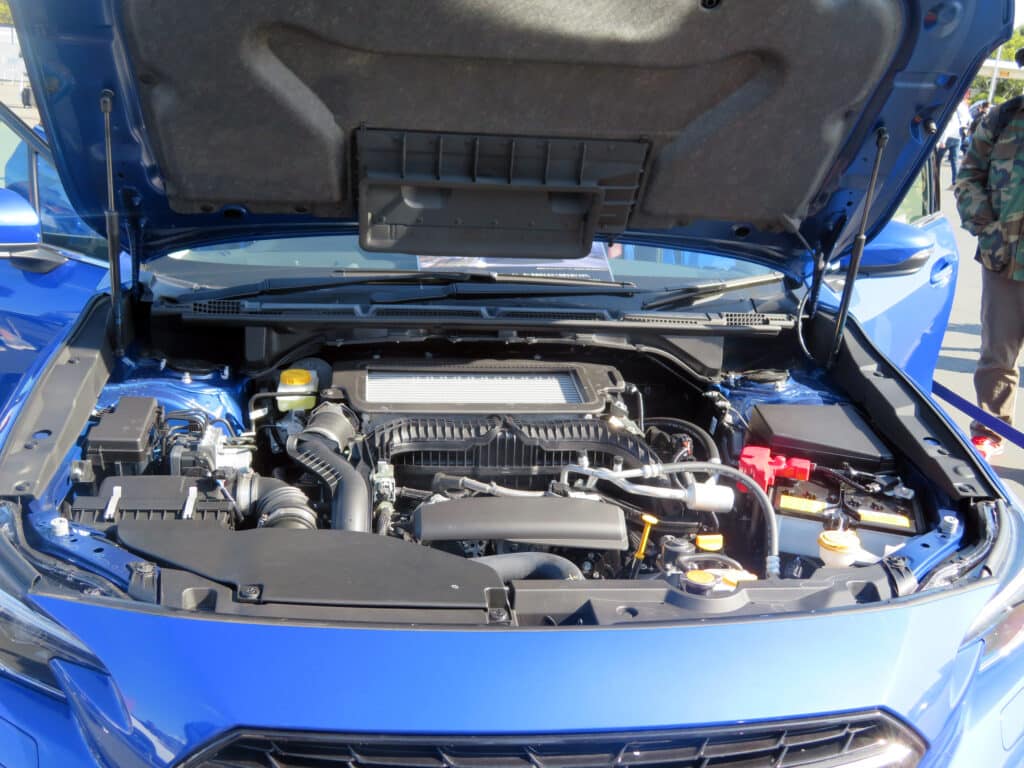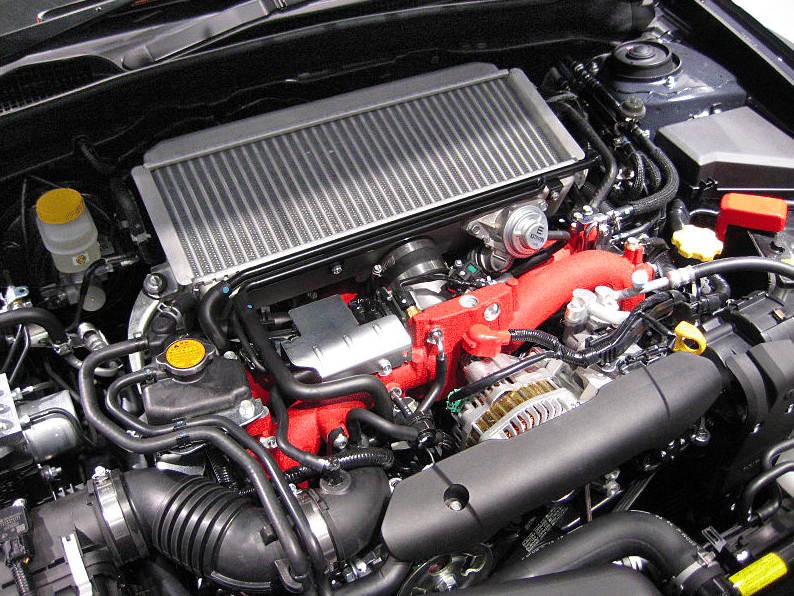Welcome to the world of Subaru, where the EJ22 engine reigns as a remarkable feat of automotive engineering. This robust powertrain has propelled countless vehicles across the globe, earning a reputation for reliability that resonates with enthusiasts and daily drivers alike. Born in the late 1980s, the EJ22 quickly became the heart of many Subaru models, from the spirited Impreza to the versatile Legacy. Its horizontally opposed design provides a lower center of gravity and delivers the distinctive rumble that Subaru aficionados have come to love.
But what makes the EJ22 so special? Let’s dive into the characteristics that define this engine:
- Flat-four configuration: This layout offers a unique balance of power, efficiency, and smoothness.
- 2.2 liters of displacement: Ample size for generating dependable performance without sacrificing fuel economy.
- Overhead cam design: Promotes better breathing for the engine, enhancing efficiency and power output.
As a Subaru owner or a potential buyer, understanding the intricacies of the EJ22 engine can be invaluable. Why, you ask? Because knowledge is power—both literally and figuratively. Familiarizing yourself with the inner workings of your engine can empower you to:
- Maximize performance: Knowing how your EJ22 engine operates allows you to optimize its potential and enjoy Subaru’s intended drive.
- Enhance longevity: Routine maintenance based on understanding the engine’s needs can extend the life of your EJ22.
- Prevent issues: Recognizing the early signs of wear and understanding common problems can save you time and money.
Subaru EJ22 Engine Overview
Embarking on a retrospective journey of Subaru’s engineering prowess brings us to the celebrated EJ22 engine—a marvel that has powered Subaru vehicles through decades of dependable service. Launched in the late 1980s, the EJ22 quickly established itself as the backbone of some of Subaru’s most iconic models.
It’s an engine that not only defined an era of automotive reliability but also cemented Subaru’s reputation for creating engines that last.
The legacy of the EJ22 is built on its robust flat-four boxer design, a testament to Subaru’s commitment to unique and effective engineering solutions. This configuration ensures a low-vibration operation, contributing to the engine’s durability and the vehicle’s balanced handling. The EJ22’s 2.2-liter displacement strikes an ideal balance between power and economy, making it a powerhouse that doesn’t shy away from efficiency.
Key features that set the EJ22 apart include its aluminum alloy block and heads, reducing weight while maintaining strength. The multi-point fuel injection system delivers precise fuel delivery, enhancing combustion efficiency and contributing to the engine’s responsive nature.
Additionally, the overhead camshaft design optimizes valve timing, improving the EJ22’s power output and fuel consumption.
The EJ22’s storied past is not just about its technical specifications; it’s about the journeys it has enabled and the confidence it has instilled in drivers who know their Subaru can tackle any challenge, road, or adventure.
Subaru EJ22 Engine Specs
When it comes to understanding the heart and soul of a Subaru from the ’90s, a closer look at the EJ22 engine’s specifications is essential. With a displacement of 2.2 liters, this boxer engine offers a harmonious blend of power and practicality, making it one of Subaru’s most revered engines.
Below is a detailed table of the EJ22 engine specifications that highlight its mechanical and performance characteristics:
| Specification | Detail |
|---|---|
| Engine Type | Flat-4, Boxer |
| Displacement | 2,212 cc |
| Bore x Stroke | 97 mm x 75 mm |
| Compression Ratio | 9.5:1 (varies by model/year) |
| Power Output | 130-145 hp @ 5,400 rpm |
| Torque | 137-149 lb-ft @ 4,400 rpm |
| Valvetrain | SOHC, 16-valve |
| Fuel System | Multi-point fuel injection |
| Engine Block Material | Aluminum alloy |
| Cylinder Head Material | Aluminum alloy |
| Timing Belt or Chain | Timing Belt |
| Interference | No, and Yes (EJ22 1990-1994 are non-interference and 95+ are interference) |
| Fuel Type | Unleaded gasoline |
| Engine Oil Capacity | 4.2 quarts (with filter) |
| Spark Plug Type | NGK or equivalent |
| Spark Plug Gap | 0.039 – 0.043 inches (1.0 – 1.1 mm) |
| Coolant Capacity | Approximately 6.9 quarts |
| Firing Order | 1-3-2-4 |
| Idle Speed | 700 rpm |
| Emissions | OBD-I or OBD-II (year dependent) |
The EJ22 is a four-cylinder boxer engine, meaning its pistons move horizontally in pairs. This unique design contributes to a lower center of gravity, providing a stable and balanced ride. The 2.2-liter displacement (or 2,212 cubic centimeters) ensures ample power without compromising on fuel efficiency. The engine’s design concerns two key principles: durability and reliability, attributes that have become synonymous with the Subaru brand.
What Cars Have A Subaru EJ22 Engine?
- Impreza 95-01;
- Legacy 90-99;
- Outback 95-96.
EJ22 Performance Metrics
In the realm of Subaru’s storied engines, the EJ22 is particularly renowned for its solid performance metrics.
Subaru EJ22 Horsepower Ratings
At the core of the EJ22 engine’s appeal is its horsepower rating. The EJ22 was rated to deliver between 130 and 145 horsepower depending on the model year and specific vehicle trim. This power output was achieved at around 5,400 rpm, providing a smooth and linear power curve that made these engines a joy to drive.
The EJ22’s horsepower is not about overwhelming force but about providing just the right amount of power for a balanced, reliable performance that drivers have come to trust for daily commuting and long-distance trips.
Torque and Performance of the EJ22 Engine
Torque, the force that actually moves your vehicle, is another area where the EJ22 shines. This engine generates between 137 to 149 pound-feet of torque, which peaks at around 4,400 rpm. This torque distribution ensures a responsive and engaging driving experience, with enough low-end power to handle city driving and sufficient mid-range strength for overtaking or climbing hills.
The torque curve is well-matched to the engine’s horsepower, leading to a harmonious driving dynamic that feels both eager and controlled.
The performance of the EJ22 is not just about the raw numbers; it’s about how those numbers translate to real-world driving. With its flat-four design, the EJ22 provides a low center of gravity that offers exceptional handling and stability when combined with Subaru’s symmetrical all-wheel drive.
The result is an engine that feels robust and spirited, capable of brisk acceleration and reliable cruising, without sacrificing the efficiency that makes it practical for everyday use.
Subaru EJ22 Engine Firing Order
The firing order of an engine is a crucial element that significantly influences its smoothness, acoustics, and balance. The Subaru EJ22 engine, with its unique boxer configuration, benefits from a firing order that complements its flat-four design.
The EJ22’s firing order is orchestrated as 1-3-2-4. This specific sequence plays a pivotal role in the engine’s operation:
- Cylinder 1: Fires first, setting the stage for the engine’s cycle.
- Cylinder 3: Follows, continuing the smooth rotational momentum established by the first.
- Cylinder 2: Ignites next, maintaining the balance and power delivery.
- Cylinder 4: Completes the cycle, ensuring a smooth transition back to Cylinder 1.
This sequence is repeated continuously as the engine runs, maintaining a harmonious rhythm that is characteristic of Subaru’s boxer engines.
The Impact of Firing Order on EJ22 Performance
The firing order of the EJ22 engine is a key factor in several performance aspects:
- Engine Balance: The opposing pistons’ movements naturally counteract each other, reducing vibrations and providing a smoother-running engine.
- Power Delivery: A well-organized firing order ensures consistent power output and better drivability.
- Acoustic Signature: The distinctive Subaru engine note is partially a result of the firing sequence, creating a sound that is music to the ears of car enthusiasts.
Here’s a simple table that outlines the EJ22 firing order:
| Cylinder Number | Firing Order Position |
|---|---|
| 1 | First |
| 3 | Second |
| 2 | Third |
| 4 | Fourth |
Understanding the firing order is not just a matter of technical knowledge; it’s about appreciating the harmony and engineering thought that goes into making the EJ22 a reliable and pleasant engine to live with. The impact of this order is felt every time the engine purrs to life and propels the vehicle forward with a sense of purpose and reliability.
Subaru EJ22 Oil Specifications
Proper lubrication is the lifeblood of any engine, and the Subaru EJ22 is no exception. Selecting the correct oil type and adhering to maintenance schedules is crucial for the engine’s longevity and performance.
Recommended Oil Types for EJ22
The EJ22 engine is designed to run optimally on a specific range of motor oils. Here’s what you need to know about selecting the right type:
- Viscosity: Subaru recommends using 10W-30 or 10W-40 viscosity oil for the EJ22, depending on the ambient temperature and driving conditions.
- Type: High-quality mineral oils were originally recommended; however, with advancements in automotive lubricants, many EJ22 owners have successfully switched to synthetic or semi-synthetic oils for enhanced protection and performance.
EJ22 Oil Capacity and Change Intervals
Maintaining the right oil level and changing the oil at appropriate intervals is essential for the health of your EJ22. Here’s a quick reference for oil capacity and change intervals:
- Oil Capacity: The EJ22 engine has an oil capacity of 4.2 quarts (including the filter).
- Change Intervals: Subaru traditionally recommended oil change intervals every 3,750 miles or 3.75 months, whichever comes first. However, some owners extend this interval using synthetic oils to 5,000-7,500 miles, depending on usage patterns.
Here’s a table outlining the key oil specifications for the EJ22 engine:
| Specification | Detail |
|---|---|
| Recommended Viscosity | 10W-30 or 10W-40 |
| Oil Type | Mineral, Synthetic, or Semi-Synthetic |
| Oil Capacity | 4.2 quarts (with filter) |
| Traditional Change Interval | 3,750 miles or 3.75 months |
| Synthetic Change Interval | 5,000-7,500 miles (varies by user) |
It’s important to use this information as a guideline and consider the specific conditions under which your vehicle operates. For instance:
- Heavy Use: Shortening oil change intervals may be prudent if you frequently drive in demanding conditions.
- Climate: Extreme temperatures can affect oil performance, so choose a viscosity that matches your local climate.
Following these oil specifications and maintenance tips can help ensure reliable service from your Subaru EJ22 engine for years to come.
Timing Belt or Chain
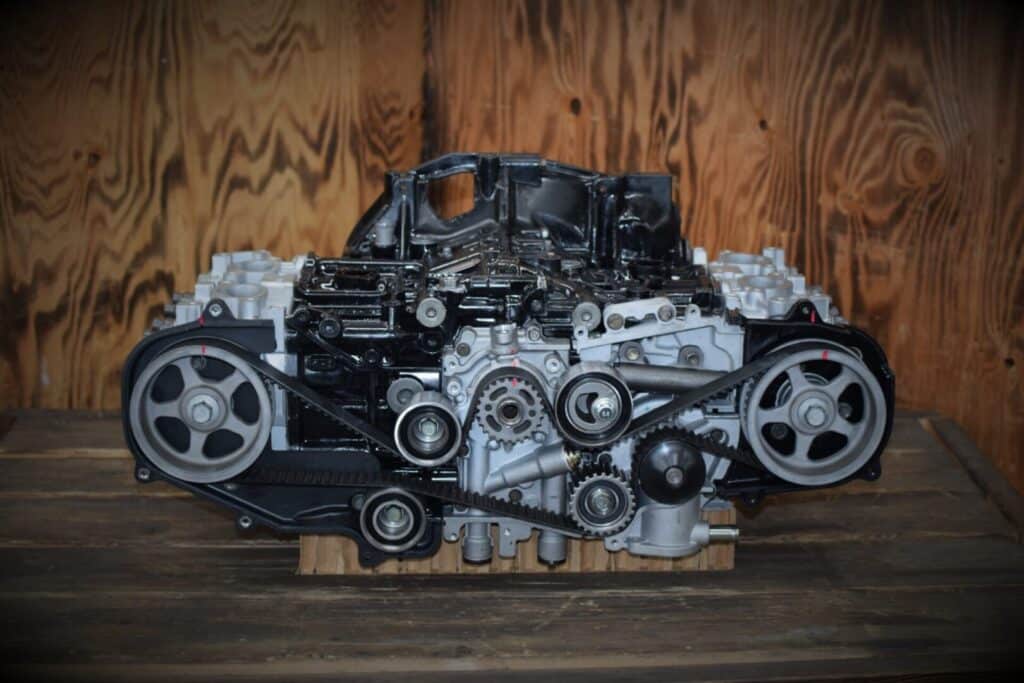
The timing system is a critical component of the Subaru EJ22 engine, dictating the synchronization of the engine’s valves and pistons. The EJ22 utilizes a timing belt, not a chain, which is a crucial part of its internal combustion process.
The EJ22’s timing belt ensures that the camshaft and crankshaft turn in unison, allowing the engine’s valves to open and close correctly during each cylinder’s intake and exhaust strokes. This precise timing is essential for optimal engine performance and efficiency.
The choice of a belt over a chain in the EJ22 can be attributed to its quieter operation and lighter weight, which generally contributes to a more refined driving experience.
To maintain the integrity of the EJ22 engine, it’s important to adhere to the following maintenance tips:
- Regular Inspection: Inspect the timing belt at each service interval for signs of wear, such as cracks or fraying.
- Timely Replacement: Subaru recommends replacing the timing belt on the EJ22 engine every 60,000 to 105,000 miles, depending on the vehicle’s service schedule and operating conditions.
- Consider Professional Assessment: Due to the technical nature of timing belt replacement and the potential for engine damage, if done incorrectly, it is often best to have this service performed by a qualified Subaru technician.
A well-maintained timing belt is key to the longevity and reliability of your EJ22 engine. Neglecting this critical component can lead to a timing belt failure, which can potentially cause severe engine damage, especially since the EJ22 is an interference engine where incorrect timing can lead to valves and pistons colliding.
Keeping on top of timing belt maintenance will ensure that your EJ22 continues to run smoothly, preserving the driving enjoyment that Subaru engines are known for.
Interference or Non-Interference Engine
The Subaru EJ22 engine is designed as an interference engine, a crucial aspect that impacts the engine’s operation and maintenance requirements.
In an interference engine, the path of the pistons and valves within the engine cylinder overlap. This design allows for higher compression and better efficiency but comes with a risk. If the timing belt fails, the pistons can collide with the valves, potentially causing significant engine damage.
What This Means for Your Subaru EJ22
For EJ22 owners, the interference nature of the engine means that diligent maintenance of the timing belt is not just recommended; it is essential. The integrity of the timing belt in the EJ22 is what keeps the synchronized dance between pistons and valves safe. Should the timing belt snap or skip a tooth, the resulting damage can be extensive and costly to repair.
Following Subaru’s maintenance schedule for timing belt replacement, which usually occurs every 60,000 to 105,000 miles, is crucial. This is the most effective way to avoid a catastrophic failure of the engine.
Moreover, replacing other timing-related components, such as tensioners and water pumps, is advisable during a timing belt service to ensure the entire system operates smoothly.
By being aware of the EJ22’s interference design, owners can take preventive measures to protect their engine’s longevity and performance.
Subaru EJ22 Fuel Consumption
Fuel efficiency is a significant aspect of the Subaru EJ22 engine, impacting both the environment and the cost of driving. The EJ22 is known for its reasonable fuel consumption for its time, balancing performance with efficiency.
The EJ22 engine, depending on the vehicle model and driving conditions, generally offers a fuel economy in the range of:
- City Driving: Approximately 20 to 22 MPG
- Highway Driving: Around 27 to 30 MPG
These figures can vary based on factors such as vehicle weight, transmission type, and driving habits.
Tips to Improve Your EJ22 Fuel Economy
To enhance the EJ22’s fuel efficiency, consider the following tips:
- Maintain Proper Tire Pressure: Underinflated tires can increase rolling resistance and reduce fuel economy.
- Use Recommended Motor Oil: Using the manufacturer-recommended grade of motor oil can improve gas mileage by 1% to 2%.
- Keep the Engine Tuned: Regular maintenance such as changing spark plugs and checking the fuel system can improve efficiency.
- Drive Sensibly: Aggressive driving (speeding, rapid acceleration, and braking) wastes fuel. Driving more smoothly can improve MPG.
- Reduce Excess Weight: Avoid carrying unnecessary items in your vehicle, especially heavy ones, as extra weight decreases fuel economy.
By following these tips and keeping your EJ22 well-maintained, you can maximize fuel efficiency and enjoy the open road with fewer stops at the gas station.
Spark Plugs and Gap Settings
Selecting the appropriate spark plugs for your Subaru EJ22 engine is pivotal to ensuring its optimal performance and longevity. The right spark plugs can significantly enhance engine efficiency, reduce emissions, and improve fuel economy.
Choosing the Right Spark Plugs for Your EJ22
When shopping for spark plugs for the EJ22 engine, you should look for:
- Material: Iridium or platinum plugs are preferred for their durability and ability to handle high heat.
- Heat Range: Appropriate heat range to prevent fouling at low temperatures and pre-ignition at high temperatures.
- Brand: Stick to reputable brands like NGK, which Subaru often recommends for their reliability and performance.
Gap Settings and Installation Tips for EJ22 Spark Plugs
The spark plug gap—the distance between the center and ground electrodes—is critical for proper ignition. For the EJ22 engine, the recommended spark plug gap is between 0.039 and 0.043 inches (1.0 – 1.1 mm). Ensuring the correct gap is essential for the following reasons:
- Fuel Efficiency: A properly gapped spark plug can significantly affect the fuel efficiency of your EJ22.
- Engine Performance: The right gap ensures optimal combustion, leading to smoother performance and acceleration.
Here are some installation tips for your EJ22 spark plugs:
- Use a Torque Wrench: To avoid over-tightening, which can damage the plug or threads, always use a torque wrench and refer to Subaru’s specifications for the correct torque.
- Check the Gap: Always verify the spark plug gap with a gap gauge tool before installation.
- Apply Anti-Seize: To prevent the plugs from seizing in the cylinder head, apply a small amount of anti-seize compound on the plug threads.
By carefully selecting the right spark plugs and adhering to the recommended gap settings and installation procedures, you can maintain the EJ22 engine’s reliability and enjoy a responsive driving experience.
EJ22 Engine Horsepower
The Subaru EJ22 engine is known for its robust performance and has historically delivered a horsepower output that ranges from a dependable 130 hp to a more spirited 145 hp. This power is made available at around 5,400 rpm, providing a solid balance between daily driving practicality and the eagerness to perform when the throttle is pressed.
Horsepower Output in the Subaru EJ22
The EJ22’s horsepower figures might not set records in today’s world of high-performance engines, but they provide more than adequate performance for the vehicles they power.
The horizontally opposed configuration of the EJ22 not only contributes to the vehicle’s low center of gravity, which aids handling but also ensures that the power delivery is smooth and linear, a characteristic treasured in Subaru engines.
How to Maximize Your EJ22’s Horsepower
For those looking to squeeze out more power from their EJ22, there are several ways to enhance horsepower:
- Air Intake: Upgrading to a performance air intake system can help the engine breathe better and improve throttle response.
- Exhaust System: A less restrictive exhaust system can increase power by allowing exhaust gases to exit the engine more efficiently.
- Engine Tuning: Re-mapping or chipping the engine’s ECU can result in a more aggressive power delivery profile and higher horsepower.
- Regular Maintenance: Keeping up with basic maintenance such as timely spark plug changes, air filter replacements, and using quality oil can also contribute to maintaining the engine’s original horsepower.
While modifications can increase horsepower, it’s important to consider the EJ22’s design limitations and the impact of changes on the overall reliability of the engine.
Consulting with a Subaru specialist can guide appropriate upgrades that harmonize with the EJ22’s engineering, ensuring that any boost in performance does not come at the expense of the engine’s famed durability.
Engine Air Filter for the EJ22
The health of the Subaru EJ22 engine is significantly influenced by the quality of air that enters it, which is regulated by the engine air filter. This component is crucial in protecting the engine from airborne contaminants that can wear engine components and degrade performance.
A well-maintained air filter is vital for several reasons:
- Engine Protection: It traps dirt, dust, and debris, preventing them from entering the engine where they can cause abrasive wear.
- Efficiency: A clean filter ensures an optimal air-fuel mixture, contributing to better combustion and, consequently, fuel efficiency.
- Performance: Adequate airflow is essential for maintaining the engine’s horsepower and torque levels.
Selecting and Replacing the EJ22 Engine Air Filter
Choosing the right air filter for your EJ22 and knowing when to replace it are key to engine maintenance:
- Quality: Select a high-quality filter that meets OEM specifications to ensure proper fit and filtration.
- Material: Consider filters made from synthetic materials that provide superior airflow and filtration compared to traditional paper filters.
- Replacement Interval: Subaru typically recommends replacing the air filter every 12,000 to 15,000 miles, but driving in dusty or polluted environments may require more frequent changes.
Replacing the air filter is a straightforward process:
- Locate the Air Filter Housing: This is usually found on top of the engine.
- Remove the Housing Cover: Unclip or unscrew the cover to access the filter.
- Replace the Filter: Remove the old filter, clean any debris from the housing, and insert the new filter.
- Secure the Housing Cover: Reattach the cover, ensuring it’s properly sealed.
Regularly checking and replacing the EJ22’s air filter can have a marked impact on the engine’s longevity and performance. It’s a simple and cost-effective way to keep your Subaru running smoothly.
Common Problems with the Subaru EJ22 Engine
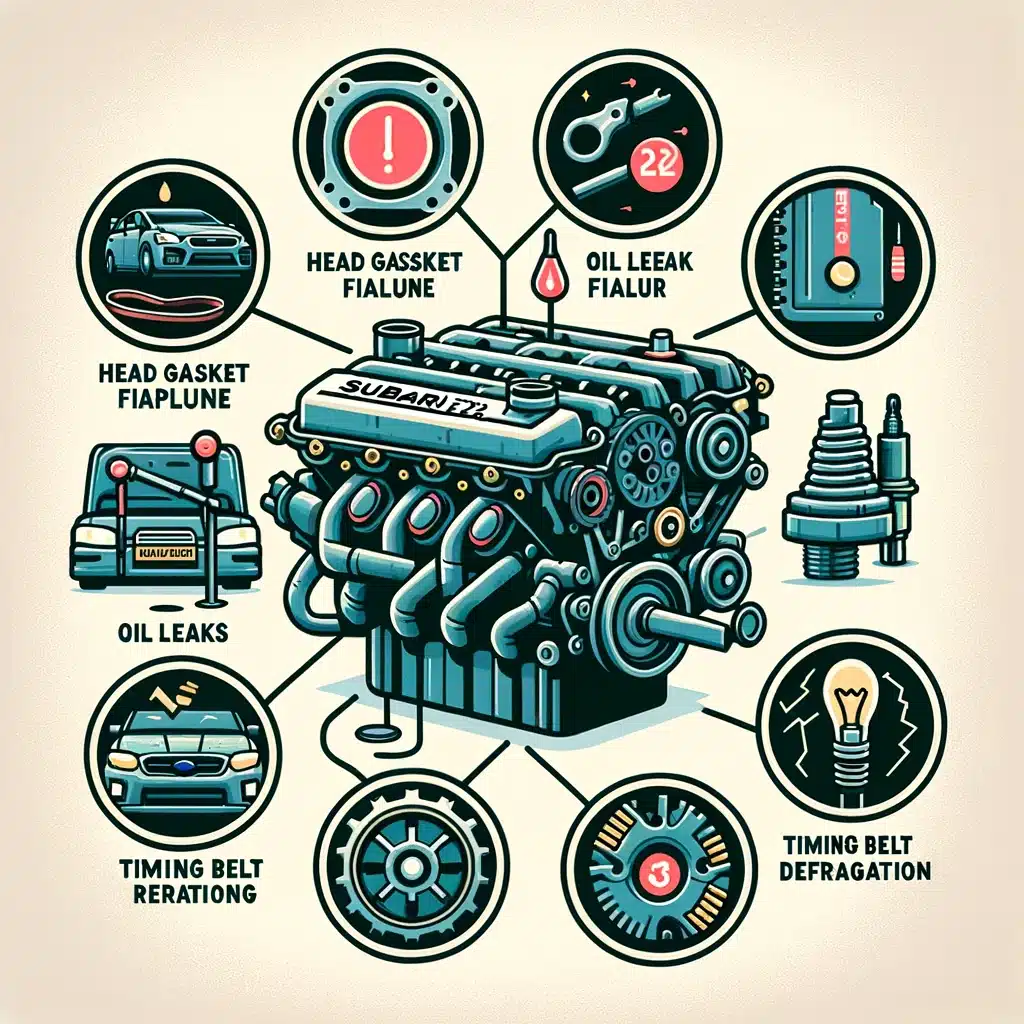
The Subaru EJ22 engine is renowned for its reliability and longevity. However, like any mechanical component, it is not without its common issues. Understanding these problems and their preventative measures can greatly increase the engine’s service life.
Several issues are known to affect the EJ22 engine, which includes:
- Head Gasket Failure: The EJ22 can be prone to head gasket leaks, especially as it ages. Symptoms include coolant leaks, overheating, and white smoke from the exhaust.
- Oil Leaks: Common areas for oil leaks include the oil pump seal, camshaft and crankshaft seals, and valve cover gasket.
- Timing Belt Wear: Since the EJ22 uses a timing belt, it is susceptible to wear and tear over time. A snapped timing belt can lead to severe engine damage.
- Spark Plug Degradation: Worn-out spark plugs can cause misfires, poor fuel economy, and reduced engine performance.
Preventative Measures and Solutions for EJ22 Problems
Adopting preventative measures can mitigate these common problems:
- Regular Inspections: Frequent inspections can catch issues early, especially for head gaskets and oil leaks.
- Timely Replacement: Replace the timing belt at the manufacturer’s recommended intervals to prevent failure.
- Quality Parts: Use high-quality replacement parts for crucial components like head gaskets.
- Routine Maintenance: Keep up with regular maintenance, including spark plug replacement, to ensure optimal engine performance.
| Common Issue | Preventative Measure | Solution |
|---|---|---|
| Head Gasket Failure | Regular inspection for leaks and overheating | Replace with a high-quality head gasket and ensure proper installation |
| Oil Leaks | Frequent checks on known leak points | Replace seals and gaskets as needed |
| Timing Belt Wear | Replace the timing belt and associated components | Replace timing belt and associated components |
| Spark Plug Degradation | Regular inspection and adherence to change interval | Replace with the correct specification spark plugs |
By staying vigilant with these aspects of your EJ22 engine, you can enjoy the renowned durability and reliability that Subaru engines are known for, keeping your vehicle on the road and running smoothly.
Reliability of the Subaru EJ22 Engine
The Subaru EJ22 engine is often lauded for its remarkable longevity and durability, traits that have solidified its status in the automotive world as a symbol of reliability. This boxer engine, with proper maintenance, is known to surpass the 300,000-mile mark, a testament to its enduring design and construction.
The EJ22’s longevity is not an accident but the result of a combination of factors:
- Robust Design: The engine’s boxer configuration contributes to a low center of gravity and less vibration, reducing wear on engine components over time.
- Quality Materials: Using aluminum alloy in the engine block and cylinder heads helps prevent rust and reduces weight, further enhancing the engine’s lifespan.
- Simplicity: The EJ22’s non-complex design makes it less prone to the intricate issues that plague more modern engines.
Real-World Reliability Stories from EJ22 Owners
Countless Subaru owners can vouch for the EJ22’s reliability with stories that are a testament to its prowess:
- One owner speaks of their Legacy hitting 400,000 miles with the original EJ22 engine still running strong, requiring nothing more than regular oil changes and timing belt replacements.
- Another recounts how their Impreza with the EJ22 endured harsh winters and rough terrain with unwavering dependability, showcasing the engine’s robust nature.
- A particularly telling story comes from an EJ22-powered Subaru that survived a significant cooling system failure. Despite overheating, the engine was undamaged, highlighting its resilience.
Such anecdotes are common within the Subaru community, painting a picture of an engine that’s not just built to last but to deliver consistent performance through the years. The EJ22’s reputation for reliability is not merely anecdotal; it’s backed by the experiences of owners who have seen these engines withstand the rigors of time and use with remarkable grace.
FAQs
1. What is the average lifespan of an EJ22 engine?
The average lifespan of a well-maintained EJ22 engine can exceed 300,000 miles. Factors such as driving habits, maintenance schedule adherence, and operating conditions can influence this figure.
2. Can I use synthetic oil in my EJ22 engine?
Yes, you can use synthetic oil in your EJ22 engine. Synthetic oils can offer better protection, especially under severe driving conditions, and may extend the time between oil changes.
3. What are the signs of EJ22 timing belt failure?
Signs of an impending timing belt failure in an EJ22 engine include a ticking noise from the engine, the engine not starting, a misfiring engine, or oil leaking from the front of the motor. It’s crucial to address these signs immediately to avoid engine damage.
4. How often should I replace the spark plugs in my EJ22 engine?
Subaru typically recommends replacing the spark plugs every 30,000 to 60,000 miles. However, this interval may vary based on the type of spark plugs used and your driving conditions.
5. What to do if my EJ22 engine overheats?
If your EJ22 engine overheats, you should stop driving as soon as it’s safe to do so. Check for obvious issues like coolant leaks or malfunctioning fans once the engine cools down. Do not attempt to open the radiator cap while the engine is hot. Overheating may cause severe damage, especially in an interference engine like the EJ22, so it’s advisable to have a professional diagnose and fix the issue.
If you’re a proud vehicle owner with a Subaru EJ22 engine under its hood, you possess an automotive history known for endurance and reliability. But, to ensure that it continues to serve you faithfully, regular maintenance is key. Treat your EJ22 to timely oil changes, belt replacements, and general tune-ups.
Remember, a well-cared-for EJ22 runs better and maintains its value, whether on the road or as a beloved classic.
We invite you to share your experiences with the EJ22 engine. Have you conquered the highest mileage club? Perhaps you’ve got some tips and tricks up your sleeve for keeping these engines purring? Or maybe you’ve got a question that’s been burning a hole in your head gasket? Drop your comments, stories, and questions below.
Let’s keep the legacy of the EJ22 alive through shared knowledge and enthusiasm.

